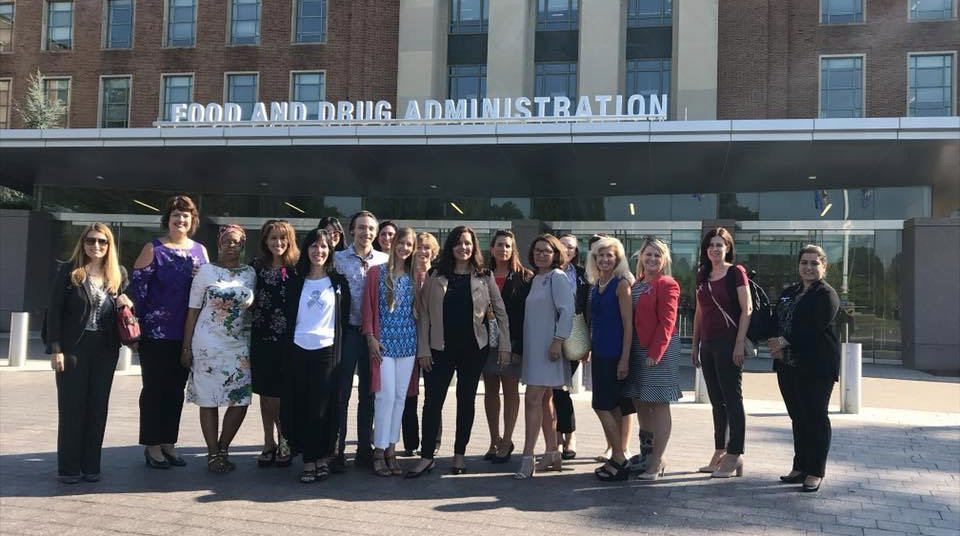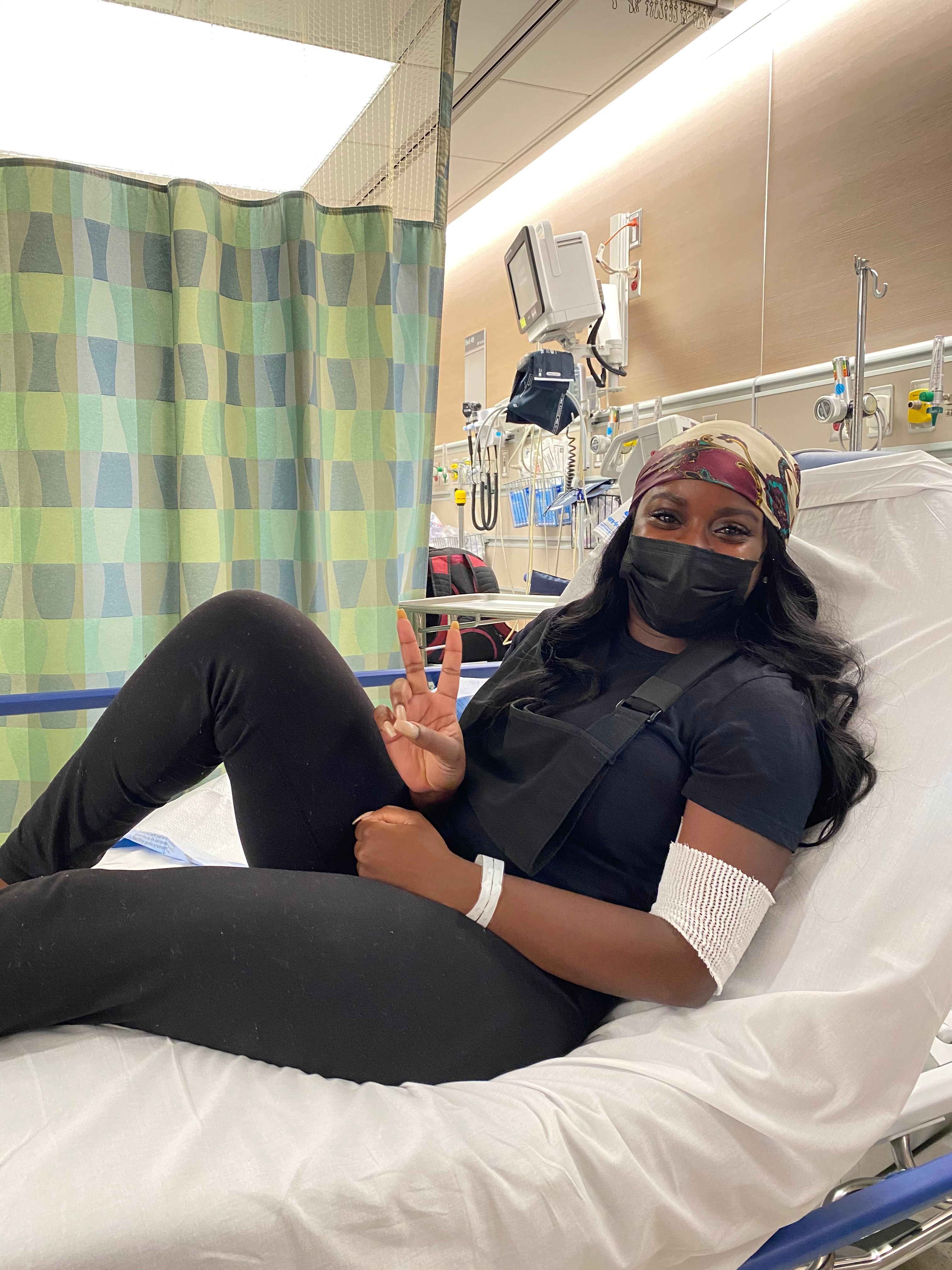“My plastic surgeon suggested I have my implants removed and replaced. By that time my health really started to decline – I would constantly be fighting a cold, I was fatigued, my eyesight was worsening – but, financially a removal was not an option for me.”
Article
An Emerging Cancer: Survivors Advocate for Women’s Health and Awareness
WOMEN’S HEALTH MONTH: Breast implant-associated anaplastic large cell lymphoma (BIA-ALCL) is impacting women globally—leaving many questions for both patients and providers.
Patient advocates, including Michelle Forney and Jennifer Cook (third and second from right), met with the FDA in September 2018 to discuss BIA-ALCL and other implant-related issues (photo courtesy of Jennifer Cook)

In January 2015, Michelle Forney started to experience intense pain and itching of her right breast. Several years earlier, she underwent breast enhancement surgery using textured implants. Understanding that implants could present complications, she immediately made an appointment with her primary care physician who invited a dermatologist to examine her.
“I was going to my physician pretty frequently and every time I’d ask, ‘what’s going on with me?” says Forney. “Every time, I would receive a different diagnosis. ‘Oh, you have shingles’ and get treated for six months, then ‘Oh you may have a virus,’ then get treated for a year. Nothing was helping.”
For two more years, Forney endured pain, itching and other symptoms. She received two mammograms, and even presented her symptoms to her plastic surgeon, where she received a third diagnosis of low-grade capsular contracture and received a fee schedule to remove and replace her implants.
She knew things were getting serious when her right breast started to swell and grew approximately 30 percent larger than her left. “My plastic surgeon suggested I have my implants removed and replaced. By that time my health really started to decline — I was constantly fighting a cold, I was fatigued, my eyesight was worsening — but, financially a removal was not an option for me.”
Running out of options, she decided to visit her OB-GYN and was referred to a breast care specialist. From there, she received a series of tests that finally revealed her diagnosis of a cancer she’d never heard of before: breast implant-associated anaplastic large cell lymphoma (BIA-ALCL).
An Emerging Cancer
Not to be confused with breast cancer, BIA-ALCL is a type of T-cell non-Hodgkin lymphoma called anaplastic large cell lymphoma (ALCL). According to hematologist/oncologist Laura Pinter-Brown, MD (UCI Health), ALCL accounts for approximately 20 percent of all T-cell lymphoma cases in the United States and is the third most common type of T-cell lymphoma. BIA-ALCL is considered a type of ALCL because of its similar molecular makeup.
“After someone has had a breast implant, in this case, textured implants, a person may experience swelling of the breast,” says Dr. Pinter-Brown. “There is fluid that accumulates on the outside of the implant that is extracted for examination. It’s found that the cells in that fluid mimic or look like the cells in ALCL.”
In most cases, BIA-ALCL is found in the scar tissue and fluid near the implant, but in some cases, it can spread throughout the body. The main symptoms of BIA-ALCL are persistent swelling, and the presence of a mass or pain in the area of the implant. In most patients, BIA-ALCL is treated successfully with surgery to remove the implant and surrounding scar tissue, and sometimes treatment with chemotherapy and radiation therapy.
There has been a causal link to textured breast implants, both silicone and saline. Because textured implants are less common than smooth, experts agree the risk of developing BIA-ALCL is low; however, the symptoms of this type of lymphoma is considered serious and can lead to death, especially if not treated promptly. To date, there has been no cases or causal link between BIA-ALCL and smooth implants.
Jennifer Cook never thought the textured implants she received in 2010 would lead to a cancer diagnosis. Especially since her plastic surgeon was a leader in the field and enrolled her in an early study to determine if textured implants were an improvement from other types. “On the consent form, I remember there being a section that addressed cancer and it stated that there was no scientific evidence linking implants to any type of cancer,” says Cook.
In 2011, the U.S. Food and Drug Administration (FDA) first identified a possible link between breast implants and ALCL
The link between textured breast implants and the disease was first reported in 1997 and the U.S. Food and Drug Administration (FDA) first identified a possible link between breast implants and ALCL in 2011. Although there have been several studies, and an announcement from the nation’s main source of drug and medical device information, many — the general public and medical community, alike — have never heard of this disease.
For Cook, a chance encounter with her students prompted her to research implants’ link to cancer. She took them to see a student play about bullying and self-esteem and heard a line that really struck her. “In the course of the play, there was a line that referenced plastic surgery. One of the characters in the play said ‘I would never do that! Haven’t you heard breast implants cause cancer?’” recalls Cook. “At first, I thought the students were just saying something reckless for shock value. It couldn’t have been true, I would’ve known it.”

Cook performed a search online for implants’ link to cancer with the expectation of not finding any evidence and using that as a teachable moment for her students to be careful about sharing information that isn’t true. She was surprised to find the FDA’s 2011 announcement linking breast implants to ALCL. Five years later, she noticed a lump in the upper part of her left breast. She immediately consulted two surgeons to talk about, and be evaluated for, BIA-ALCL. But like Forney, she was having difficulty getting answers and her symptoms started to get worse.
“Before I was officially diagnosed, I started seeing my symptoms change. My breast was increasing in size and I knew I needed to get treated immediately,” says Cook. “The plastic surgeon I reached out to didn’t understand my symptoms and thought I was unhappy with my implants and wanted my health insurance to pay for a removal. I was just alarmed by his dismissal.”
Advocating for Women’s Health
During an FDA advisory committee meeting in 2019 to hear testimony from a panel of patients, plastic surgeons and oncologists about the safety of implants, it was reported that there are more than 500 BIA-ALCL cases worldwide (304 in the U.S.) and 34 deaths.
Forney and Cook took part in conversations with the FDA, including a joint meeting with patient advocates in 2018 to bring light to this emerging cancer and the need to inform women of BIA-ALCL and other implant-related issues. Both have made it their mission to raise awareness and connect with as many women impacted by this blood cancer to provide support and information so they can be their own health advocates.
“It’s important for everyone to be their own health advocate,” says Cook. “You know your body and you are the best person to communicate to doctors what is going on with you and really push for additional tests or a second opinion.”
More than 400,000 women received implants in 2018
The impact of BIA-ALCL could be much greater than presently reported. According to the American Society of Plastic Surgeons 2018 Plastic Surgery Statistics Report, more than 400,000 women received implants. A simple search on Facebook found several community groups dedicated to BIA-ALCL with more than 2,000 members sharing their journey and symptoms connected to the disease. Forney and Cook are administrators for one of the Facebook groups and are Breast Implant Lymphoma Advocates (BILA) on the BILA information site, biaalcl.com.
“When I was diagnosed, I went searching on the internet to learn as much as I could about the disease. That’s when I found the Facebook group and became very active with the other women,” says Cook. “I thought, Okay, I could be one in a million and was very unlucky, or this could be something that is happening to lots of women. I wanted to help.”
In response to the FDA’s request for a recall following its advisory committee meeting and subsequent Medical Device Report (MDRs) reporting worldwide cases of BIA-ALCL and BIA-ALCL-related deaths, Allergan, the manufacturer of BioCell textured implants, voluntarily removed millions of its textured implant products from the global market.
Since the recall, the Lymphoma Research Foundation’s Helpline has received numerous calls and emails from women seeking more information about textured implants, BIA-ALCL and guidance on what they should do if they experience symptoms. Many expressed concerns about their particular implant and if they were part of the voluntary recall. Some inquired as to whether their diagnosis of lymphoma (whether it was ALCL or another subtype) may be connected to their implants.
“BIA-ALCL remains an obscure diagnosis for many patients and clinicians alike, so raising awareness about this lymphoma is paramount,” says Victor Gonzalez, Associate Director of Support Resources and Strategic Partnerships at the Lymphoma Research Foundation. “People who contact the LRF Helpline often express frustration at the lack of detailed information and confusion about what steps to take when it comes to this disease, so making sure patients are informed of their options is important to ensure the best possible health outcomes.”
Since their diagnoses, Forney and Cook have received treatment for their lymphoma and stay on top of their follow-up PET/CT scans to monitor recurrence. Although they are happy with the steps being taken to protect women’s health, they both shared that there is still more work to do in educating the public and medical community of this disease, improving the relationship between patient and doctor and removing the stigma around plastic surgery.
“We’ve heard so many stories from women who encountered so many roadblocks before they get answers,” says Forney. “A roadblock when you’re speaking with a medical professional that never heard of this disease; a roadblock with health insurance because many women need a referral to get tested; and a roadblock from the guilt you feel from public judgment. It’s an emotional rollercoaster.”




